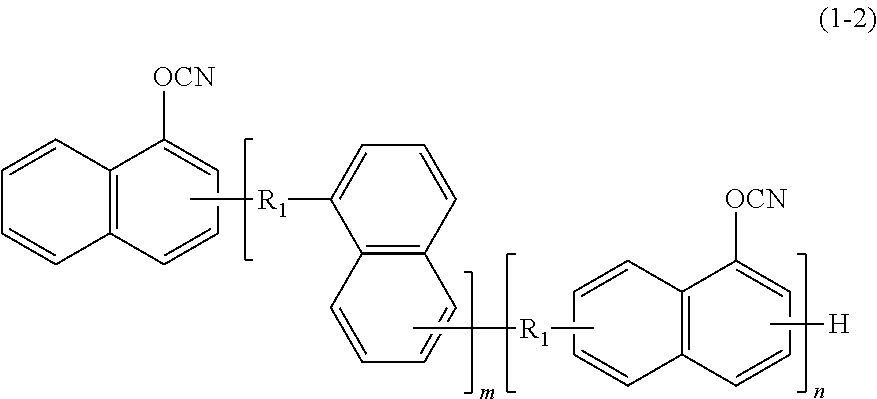Material for forming underlayer film for lithography, composition for forming underlayer film for lithography, underlayer film for lithography, resist pattern forming method, and circuit pattern forming method
a technology of resist pattern and film thickness, which is applied in the direction of photosensitive material processing, photomechanical equipment, instruments, etc., can solve the problems of difficult to achieve resist pattern having a film thickness sufficient for processing a substrate, and the intrinsic limitation of light source resolution, so as to achieve excellent heat resistance and etching resistance
- Summary
- Abstract
- Description
- Claims
- Application Information
AI Technical Summary
Benefits of technology
Problems solved by technology
Method used
Image
Examples
examples
[0193]Hereinafter, the present embodiment will be described in more detail by Synthesis Examples, Examples and Comparative Examples, but the present embodiment is not limited thereto at all.
[0194][Carbon Concentration and Oxygen Concentration]
[0195]The carbon concentration and the oxygen concentration (% by mass) were measured by organic element analysis with the following apparatus.
[0196]Apparatus: CHN CORDER MT-6 (trade name, manufactured by Yanaco Bunseki Kogyo Co.)
[0197][Weight Average Molecular Weight]
[0198]Gel permeation chromatography (GPC) analysis with the following apparatus and the like was used to determine the weight average molecular weight (Mw) in terms of polystyrene.
[0199]Apparatus: Shodex GPC-101 type (trade name, manufactured by Showa Denko K. K.)
[0200]Column: KF-80M×3
[0201]Eluent: THF 1 mL / min
[0202]Temperature: 40° C.
[0203][Solubility]
[0204]The amount of the compound dissolved in propylene glycol monomethyl ether acetate (PGMEA) was measured at 23° C., and the re...
example 3
[0237]The composition for forming an underlayer film for lithography in Example 1 was coated on a SiO2 substrate having a film thickness of 300 nm, and baked at 240° C. for 60 seconds and further at 400° C. for 120 seconds to thereby form an underlayer film having a film thickness of 70 nm. A resist solution for ArF was coated on the underlayer film, and baked at 130° C. for 60 seconds to thereby form a photoresist layer having a film thickness of 140 nm. As the resist solution for ArF, one prepared by blending 5 parts by mass of the compound of the following formula (12), 1 part by mass of triphenylsulfonium nonafluoromethanesulfonate, 2 parts by mass of tributylamine, and 92 parts by mass of PGMEA was used.
[0238]A compound of following formula (12) was prepared as follows. That is, 4.15 g of 2-methyl-2-methacryloyloxyadamantane, 3.00 g of methacryloyloxy-γ-butyrolactone, 2.08 g of 3-hydroxy-1-adamantyl methacrylate and 0.38 g of azobisisobutyronitrile were dissolved in 80 mL of te...
example 4
[0240]Except that the composition for forming an underlayer film for lithography in Example 2 was used instead of the composition for forming an underlayer film for lithography in Example 1, the same manner as in Example 3 was performed to provide a positive-type resist pattern. The evaluation results are shown in Table 2.
PUM
| Property | Measurement | Unit |
|---|---|---|
| temperature | aaaaa | aaaaa |
| reaction time | aaaaa | aaaaa |
| reaction time | aaaaa | aaaaa |
Abstract
Description
Claims
Application Information
 Login to View More
Login to View More - R&D
- Intellectual Property
- Life Sciences
- Materials
- Tech Scout
- Unparalleled Data Quality
- Higher Quality Content
- 60% Fewer Hallucinations
Browse by: Latest US Patents, China's latest patents, Technical Efficacy Thesaurus, Application Domain, Technology Topic, Popular Technical Reports.
© 2025 PatSnap. All rights reserved.Legal|Privacy policy|Modern Slavery Act Transparency Statement|Sitemap|About US| Contact US: help@patsnap.com



